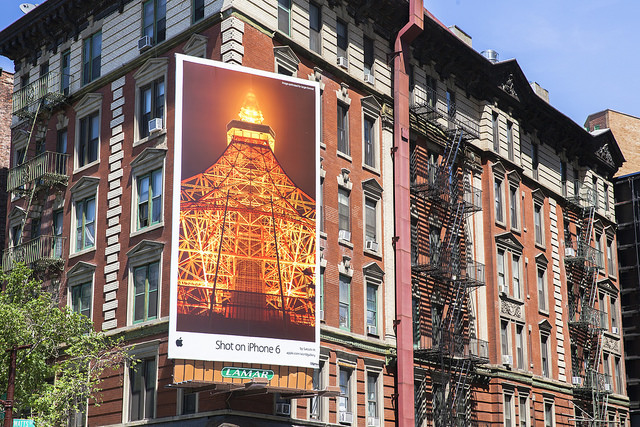Unlock the Magic in Your Story Now
Get the Free 20 questions to Ask Before Launching Your Idea workbook when you sign up for occasional updates.
Get the Free 20 questions to Ask Before Launching Your Idea workbook when you sign up for occasional updates.
Articles filed in: Storytelling
The Weight Of Our Words
filed in Storytelling, Strategy
 The laminated sign next to the order and pay point at the cafe read:
The laminated sign next to the order and pay point at the cafe read:
“We can’t and we won’t serve you while you are ON the phone. We need to engage.”
These are the first words that greet every single customer (not just the rude ones).
On the flip side, when I email a colleague who has a key leadership role at a multi-billion dollar company, he always responds as if I was the person he most wanted to hear from that morning.
He goes out of his way to make everyone he touches feel like they matter.
Our words communicate much more than the messages we want people to hear. How we use them shapes our thoughts and character—it shows people what we value and conveys the truth about who we are. Our every word has the power to provoke or reassure, draw people in or push them away. We get to choose how well and how wisely we use them.
Image by Steve McClanahan
The Three-Act Structure For Brand Stories
filed in Marketing, Storytelling
 Every movie you’ve ever watched follows a three-act structure. The screenwriter sets the scene, introducing us to the hero and the main characters. We get a glimpse of his world, relationships and challenges. In the second act, we see the hero attempt to solve his problems or overcome obstacles.
Every movie you’ve ever watched follows a three-act structure. The screenwriter sets the scene, introducing us to the hero and the main characters. We get a glimpse of his world, relationships and challenges. In the second act, we see the hero attempt to solve his problems or overcome obstacles.
In Toy Story, we’re introduced to Woody who has been Andy’s favourite toy forever. Buzz Lightyear comes along and turns Woody’s world upside down. The whole plot is about how Woody deals with the resulting conflicts while remaining loyal to Andy and true to his values.
We can use this three-act structure in our brand stories, remembering that the customer, not the brand is the hero.
The Three-Act Structure For Brand Stories
SETUP: The customer’s backstory unfolds
We explore his hopes, dreams, wants, needs, values, worldviews, and challenges.
CONFRONTATION: The struggle arises
The customer attempts to solve his problem or fulfil his need and often realises he needs help.
RESOLUTION: Challenges are overcome
The customer’s need is met. He manages to do the thing he wanted to do, but couldn’t.
He is changed, has a new sense of self and set of beliefs about what’s possible.
Analyse any great product or service story from the IKEA chair to Blue Apron meal kits, from Warby Parker to charity: water and you’ll see it follows this three-act structure.
How does your story stack up?
Do you want to tell a better brand story? The Story Strategy Course will show you how.
Image by David Werner.
Why Do They Come?
filed in Marketing, Storytelling
 There was a twenty-minute wait for croissants at Lune long before the New York Times announced that the best croissants in the world might just be made in Melbourne. Now you can wait for thirty, but people still get up early and hang in there just to try one.
There was a twenty-minute wait for croissants at Lune long before the New York Times announced that the best croissants in the world might just be made in Melbourne. Now you can wait for thirty, but people still get up early and hang in there just to try one.
Why would they take a tram across town for a $5 pastry?
Why does someone buy a Maserati, not a Tesla?
Why don’t cinema goers save the $20 and stay at home with Netflix?
Why do your customers come to you?
It’s not possible to tell your story effectively without knowing the answer to this question.
How many of the reasons that you list are reflected in your marketing?
Inage by Lars Ploughmann.
The Real Role Of Storytelling In Marketing
filed in Marketing, Storytelling
 When we think about using storytelling as a marketing tactic we often get confused about the purpose of the story. Most marketing tries to tell the story of the product. We invite prospective customers to pay attention to our widget by describing what it does or why it’s better and think we’re telling a story.
When we think about using storytelling as a marketing tactic we often get confused about the purpose of the story. Most marketing tries to tell the story of the product. We invite prospective customers to pay attention to our widget by describing what it does or why it’s better and think we’re telling a story.
Analyse any piece of marketing collateral that resonates with you and you’ll realise that the company doesn’t tell the story of the product at all. What they do instead is tell the story of the customer in the presence of the product. The customer, not the product is the hero of the story.
From Apple’s ‘Shot on iPhone’ billboards and IKEA’s ‘Start Something New’ folding chair, to Cook Republic’s Panna Cotta and Johanna Basford’s colouring books. The customer is the star of the show and the product is the supporting act.
Your job is to show your customer how your product makes him the hero of his story.
Image by Billie Grace Ward.
True Advantages
filed in Marketing, Storytelling
 If I asked you to list the advantages any global brand has over its competitors you’d likely think of things like access to capital, distribution networks, and other resources that the average business doesn’t have. But these brands are the outliers.
If I asked you to list the advantages any global brand has over its competitors you’d likely think of things like access to capital, distribution networks, and other resources that the average business doesn’t have. But these brands are the outliers.
When it comes down to it, most businesses have access to similar resources, raw materials, and human capital. Every pizza is made with flour, cheese, and tomato. So why do queues form at this place and not that one? What drives the demand that’s responsible for success?
The one true advantage we all have at our fingertips is how we make people feel, and the story they leave with. Sometimes that story is a two-hour wait, a $5 price tag for a single slice, or a hand-made pizza crafted by a man who has been making them for 50 years.
Understanding how people will tell the story to others is an advantage every business can own.
Image by Lucas Richarz.
Responsive Marketing
filed in Marketing, Storytelling
 There are two approaches to selling memberships at the local gym. The first is to show the prospective member the facilities—highlighting the abundance of equipment and classes, and then to offer a ‘limited time only’ joining discount. The second is to spend time listening to the reasons why he wants to join in the first place and then to tailor the sales conversation to those needs.
There are two approaches to selling memberships at the local gym. The first is to show the prospective member the facilities—highlighting the abundance of equipment and classes, and then to offer a ‘limited time only’ joining discount. The second is to spend time listening to the reasons why he wants to join in the first place and then to tailor the sales conversation to those needs.
Two Things Your Marketing Messages Must Do
1. Communicate to the customer that you have understood his unmet needs or unspoken desires.
2. Paint a picture of the customer as the hero of the story in the presence of your product (a lot of marketing messages have this backward).
Average marketing is filled with statements of fact. Great marketing is a response to the customer’s problems and desires. It’s the difference between, ‘this is better’ and ‘this is how we can help you to be better’.
Image by midwestnerd
The Difference Between Saying You Care And Caring
filed in Marketing, Storytelling
 I’m not sure when we became defensive about customer care became. I suspect it might have been when we began to put more distance between the customer and us. In the days when there was a cash register that rang with ‘real money’, when we sold eye-to-eye and transacted hand-to-hand, instead of digitally, we had no choice but to ‘see’ our customers. The transaction itself was as good as a handshake. Word and bond. No us and them, only us.
I’m not sure when we became defensive about customer care became. I suspect it might have been when we began to put more distance between the customer and us. In the days when there was a cash register that rang with ‘real money’, when we sold eye-to-eye and transacted hand-to-hand, instead of digitally, we had no choice but to ‘see’ our customers. The transaction itself was as good as a handshake. Word and bond. No us and them, only us.
Now we build barriers. We expect the customer, not the company, to take responsibility. We create guarantees that protect us from having to fulfil them. We armour up against customers. We require proof of purchase that leaves no room for us to be exploited by the shady few and sadly, fewer opportunities to delight the honest majority.
So when we find a company that cares, no questions asked we should celebrate them. When I buy a Crumpler bag it comes with a lifetime warranty. If it fails, I can bring it back, and they will repair it. The only proof of purchase I need is the product that let me down. What a breath of fresh air.
Caring is simpler than you think. What story does your customer care tell about your company?
Image by Anna D.
 It’s easy to think of great examples of B2C (business-to-consumer) brand storytelling. The list of B2C companies that leverage storytelling to engage with their customers’ grows daily. The perception in many B2B (business-to-business) companies is that it’s easier to engage with customers through story when you’re selling running shoes with a dose of ‘Just Do It’ motivation. Then there is the concern in B2B about justifying the resources and measuring the return on investment (ROI) in brand storytelling to stakeholders.
It’s easy to think of great examples of B2C (business-to-consumer) brand storytelling. The list of B2C companies that leverage storytelling to engage with their customers’ grows daily. The perception in many B2B (business-to-business) companies is that it’s easier to engage with customers through story when you’re selling running shoes with a dose of ‘Just Do It’ motivation. Then there is the concern in B2B about justifying the resources and measuring the return on investment (ROI) in brand storytelling to stakeholders.  I was at the local garden centre on Sunday. There amongst the shrubs, trellis fencing and climbing plants was a comfortable-looking, but otherwise, unremarkable garden chair with wooden arms. Unremarkable that is until you read the description on the flip side of the $300 price tag.
I was at the local garden centre on Sunday. There amongst the shrubs, trellis fencing and climbing plants was a comfortable-looking, but otherwise, unremarkable garden chair with wooden arms. Unremarkable that is until you read the description on the flip side of the $300 price tag. As marketers, we often skip the important step of assessing our marketing goals against customer objectives. As a consequence, we fall in love with our message and forget to question what it is the customer needs to know or wants to hear. It’s not hard to check if this is true of your company—simply answer the following two questions.
As marketers, we often skip the important step of assessing our marketing goals against customer objectives. As a consequence, we fall in love with our message and forget to question what it is the customer needs to know or wants to hear. It’s not hard to check if this is true of your company—simply answer the following two questions.